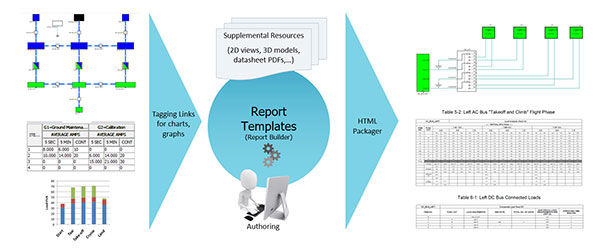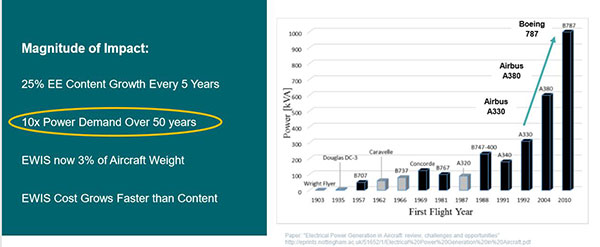Siemens Launches Capital Load Analyzer Software for Aerospace
Making use of an electrical digital twin can reduce aerospace electrical compliance and certification risks.

An example of Mentor Capital visual report generation. Image courtesy of Siemens PLM Software.
Latest News
May 28, 2019
Siemens' Mentor business has introduced the Capital Load Analyzer software product to help simplify aircraft electrical design compliance and certification. Modern aircraft systems, such as electrical flight control systems and in-flight entertainment systems, require more power, have more electrical content and have higher compliance risk due to increased complexity. According to market research firm Bishop & Associates Inc., for 2019 the market for commercial air cable/harness assemblies is projected at approximately $2.4 billion, growing to $3.3 billion in 2024, with a compound annual growth rate of just over 6.5%. The new Capital Load Analyzer is the industry’s first electrical systems technology that leverages automation and digital data continuity to facilitate regulatory compliance, according to Mentor.
The company says current methods for verification and analysis rely on fragmented data, and are typically conducted manually using drawings and spreadsheets, after the major electrical design work is complete. Uncovering problems during this late program phase forces costly design iterations and missed critical milestones, such as Customer Acceptance and Type Certification, impacting aircraft revenue recognition.

To mitigate such risks, the new Capital Load Analyzer product draws upon the electrical digital twin, generated from the overall power system and subsystems design, to predict the aircraft’s electrical power demand. Mentor says the digital twin, native to the Capital product, is an accurate, up-to-date version of the electrical system as it evolves during the development process. The electrical digital twin provides an automated view of the entire power system, helping engineers to design for compliance from the very beginning of the project. Analysis and simulation can be performed using primary design data. Rules-based checking and analysis helps enable accurate and complete verification for aircraft power system efficiency for each flight phase—even under load shedding for emergency conditions, according to the company.
“By leveraging the new Capital Load Analyzer, we anticipate engineers will be able to mitigate risk in a variety of certification types to meet airline safety requirements,” says Dick Slansky, ARC Advisory group senior analyst via a press release. “Electrical systems for new aircraft have become much more complex to meet the ever increasing demands of advanced avionics and expanded cabin amenities. Creating an electrical digital twin using Capital Load Analyzer at all phases of the aircraft’s product lifecycle could result in considerable time and costs savings while achieving higher-performance electrification of today’s aircraft.”
Data Management for Comprehensive Analysis and Reporting
Siemens PLM Software says Capital Load Analyzer automatically extracts all electrical load analysis data into the user’s own reporting template for easy and efficient report generation. This technology pulls data directly from the digital twin so the user can see the impact of design changes at any time and at any stage of the design process, according to the company. The ability to quickly generate real-time reports enables users to monitor design tasks and identify potential issues early in the design process, thereby mitigating program risk. The Capital Load Analyzer product reports compliance analysis results for each design configuration and variant.
“Capital Load Analyzer is a true electrical collaboration platform that provides the digital continuity required across a broad range of critical tasks for electrical systems compliance and certification,” says Martin O’Brien, senior vice president, Integrated Electrical Systems, Siemens Digital Industries Software via a press release. “Capital’s digital thread allows aerospace electrical system designers to deploy an automated design-for-compliance methodology with greater efficiency, improved product quality and a competitive advantage“
Siemens is further extending the Capital product line to include two additional technologies. A new wire derating product optimizes the aircraft’s wire sizes to reduce weight while maintaining integrity against hazards, such as over-heating. And the new 3D signal separation tool evaluates the electrical design against safety-critical design considerations, such as power routing requirements and harness spacing for redundant systems. These products ship in the second half of 2019.
All of these new technologies will also be showcased at the Siemens Detroit Realize Live user conference (June 10 – 13, 2019) and the International Paris Air Show, Le Bourget (June 17-23, 2019) in the Siemens Chalet. For more information, visit the Capital product website.
Sources: Press materials received from the company and additional information gleaned from the company’s website.
More Mentor Graphics Coverage
More Siemens Digital Industries Software Coverage
Subscribe to our FREE magazine, FREE email newsletters or both!
Latest News
About the Author
DE’s editors contribute news and new product announcements to Digital Engineering.
Press releases may be sent to them via [email protected].






